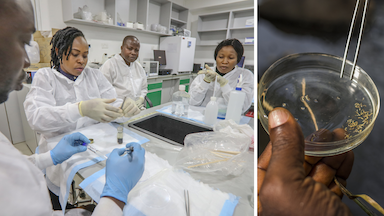(An excerpt from the Mectizan Donation Program Annual Highlights for 2021)
When national river blindness and LF elimination programs reach the point where they suspect transmission has been interrupted or the disease is no longer a public health problem, they implement transmission assessment surveys (TAS) using biological diagnostics to determine whether treatment can be safely stopped.

These assessments, which occur multiple times during the post-treatment surveillance period, are part of the monitoring and evaluation (M&E) process—a critical step on the road to elimination as it validates whether mass drug administration is achieving or has achieved its goals.
The M&E process involves:
- Epidemiological surveys to detect the presence in children of antibodies for onchocerciasis or the circulating antigen of lymphatic filariasis; and
- Entomological surveys using polymerase chain reaction (PCR) testing on black fly specimens collected in many sites of an endemic focus to determine whether there are onchocerciasis parasites in the vector, a sign of ongoing transmission in the focus.
To build capacity, it is important that countries have quality-assured laboratories and well-trained technicians to run the tests.
